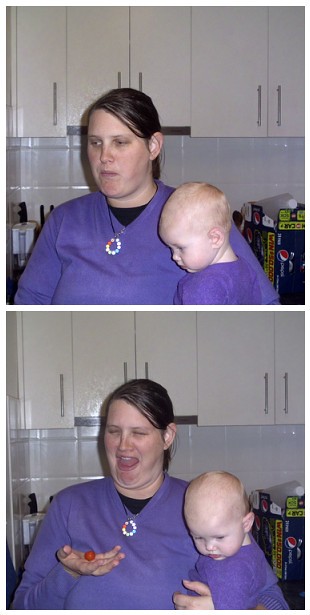 This week Harri chose Zambia, from a friend's poster map. Some Internet research taught us that a popular Zambian dish is Nshima (also popular in other African countries). Nshima is made from corn flour and water, to us Australians that is. To our foreign friends corn flour is known as maize and corn meal. Nshima is served with Ndiwo, a side dish (or two) known to Westerners as relishes, made with vegetables, peanut powder and sometimes meat.
This week Harri chose Zambia, from a friend's poster map. Some Internet research taught us that a popular Zambian dish is Nshima (also popular in other African countries). Nshima is made from corn flour and water, to us Australians that is. To our foreign friends corn flour is known as maize and corn meal. Nshima is served with Ndiwo, a side dish (or two) known to Westerners as relishes, made with vegetables, peanut powder and sometimes meat.It was interesting to learn that Nshima is more than a dish, it comes with a rich (and controversial) history. The way Nshima is prepared, served and eaten is steeped in cultural tradition. For example everyone eating the meal must wash their hand first, using a jug to pour water over their hands, which falls into a large bowl beaneath their hands. The order in which family members wash their hands and are served their Nshima is based on age and sex, with older males being first in line.
"Zambians are generally raised to believe that only nshima constitutes a full and complete meal. Any other foods eaten in between are regarded either as snacks or a temporary less filling or inadequate substitute or a mere appetizer. Lets say you meet a Zambian late in the afternoon and ask him if he or she has eaten. Most likely they will tell you that they haven’t eaten all day although they might have eaten a sandwich, peanuts, milk, and a few other non-nshima foods.
Nshima is such a key factor loaded with such emotional investment in the diet that many rituals, expectations, expressions, customs, beliefs, and songs have developed in the culture around working for, cooking, and eating of nshima. For example, nshima is best when eaten steaming hot. A Chewa speaking man in Eastern Zambia, in moments of great masculine exuberance might say:
"Ndine mwamuna ine, yikapola ndi ya mwana!"
"I am a man who eats only hot nshima, if its cold I give it to children."
We got together ingredients to make Nshima (corn flour and water) and two Nwido dishes. We did a beef Nwido which included onion, peanut powder (from peanuts we crushed ourselves), onion, cherry tomatoes, vegetable oil and a spinach one that included everything from the first, except the beef.
We prepared our vegies, crushed our peanuts, boiled our beef and then got started on the Nshima. First batch was a lumpy disaster. Second batch was looking good, but when we finished it we realised it wasn't thick enough, tried adding more flour and then ended up with another lumpy batch. By this time it had been a long time since we started cooking, so we decided to give up and eat what we had.
it had been a long time since we started cooking, so we decided to give up and eat what we had.
Before eating we did the hand washing ritual, which was the highlight of the meal. Harri barely ate a single mouthful, but spent a lot of time washing her hands throughout mealtime. Adults ate out of hunger, but agreed the recipes had gone horribly wrong, though we don't know how. It provided many laughs and we agreed to never eat it ever again.
Also, in the interests of natural learning and being open to cultures other than our own, I intentionally tasted a tomato for the for the first time in 22 years.
Tomatoes and I just aren't friends (big thanks to Huz for capturing these moments lol).
So that was Zambia night. Huz is hopeful that next week Harri might choose the US ;)
We prepared our vegies, crushed our peanuts, boiled our beef and then got started on the Nshima. First batch was a lumpy disaster. Second batch was looking good, but when we finished it we realised it wasn't thick enough, tried adding more flour and then ended up with another lumpy batch. By this time
 it had been a long time since we started cooking, so we decided to give up and eat what we had.
it had been a long time since we started cooking, so we decided to give up and eat what we had.Before eating we did the hand washing ritual, which was the highlight of the meal. Harri barely ate a single mouthful, but spent a lot of time washing her hands throughout mealtime. Adults ate out of hunger, but agreed the recipes had gone horribly wrong, though we don't know how. It provided many laughs and we agreed to never eat it ever again.
Also, in the interests of natural learning and being open to cultures other than our own, I intentionally tasted a tomato for the for the first time in 22 years.
Tomatoes and I just aren't friends (big thanks to Huz for capturing these moments lol).
So that was Zambia night. Huz is hopeful that next week Harri might choose the US ;)



1 comment:
Sazz, I wonder if you saw any of the SBS program Go Back to Where You Came From? which was on two weeks ago and is available to watch online. While I certainly wouldn't suggest the whole thing for Harri,the first episode showed an African family sharing a meal with the Australians and showed them hand washing and then eating - might be interesting vision to share with Harri.
The program itself is worth seeing - confronting.
Post a Comment